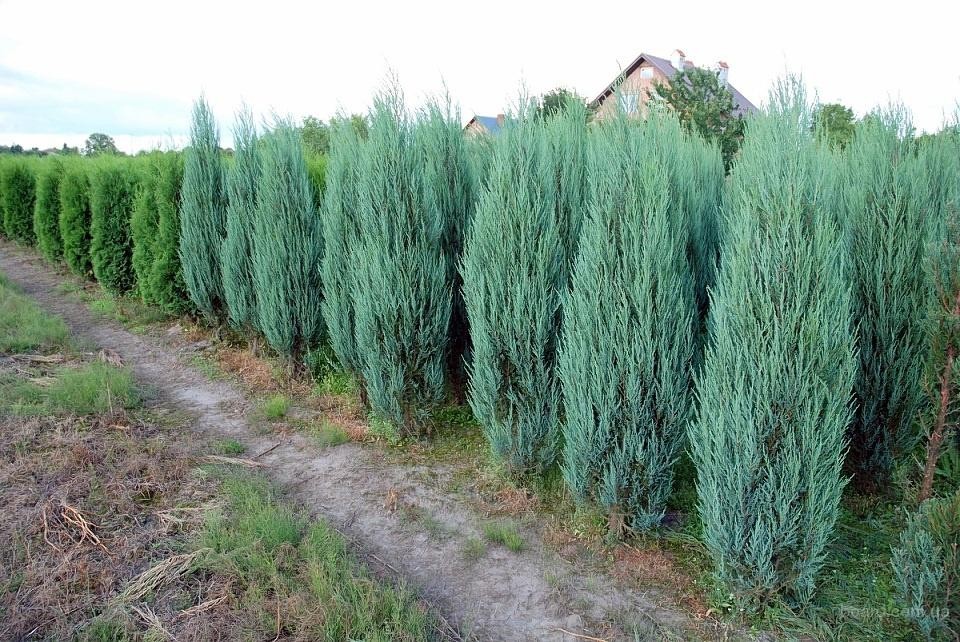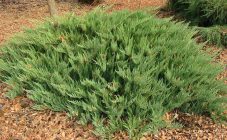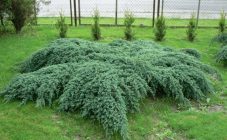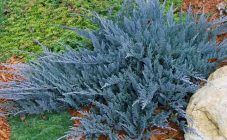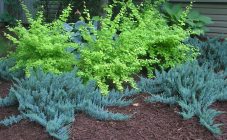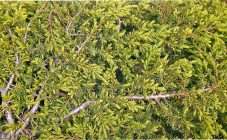Content:
Rocky juniper is a representative of the Cypress family, or Cupressaceae in Latin. The homeland of the juniper is the Arctic and the mountain ranges of the subtropics. Further in the text, a detailed description of the Blue Arrow juniper will be considered, and information is provided not only on the procedures for its cultivation and reproduction, but also on the areas in which it is used.
The Blue Arrow rocky juniper got its name from the fact that it looks like an arrow shot into the sky and its blue color.
Characteristic
Sheet
The green mass is presented in the form of needles in the form of scales. In diameter it reaches up to 75 cm. At the base of the trunk there is a blue tint, which changes to blue towards the end of the branches.
Trunk
The tree can grow in height from 700 cm to 5000 cm. In addition to the main height, growth can be increased by 16 cm at a rate of 365 days.
Fetus
The harvest is represented by cones that have the shape of a berry and are blue to blue in color.
Agrotechnics
Site preparation
In order for the shrub to quickly take root, you must:
- choose a place - it should be on the sunny side of the site and well protected from drafts;
- check the soil for acidity and, if it rises, add lime;
- make the hole larger than the shrub so that the plant can freely adapt to the new environment;
- fill half of the hole with the following layers:
- 15-20 cm drainage - in the form of rubble;
- 15 cm - peat;
- 10 cm - leaf compost;
- 10 cm - sand.
Disembarkation
In order for the plant to easily endure the pick, it is desirable:
- take the Blue Arrow juniper with the land in which he originally lived;
- place in a previously prepared hole without deepening the neck of the tree;
- water well and wait for the water to be absorbed;
- sprinkle with the previously given mixture to make the earth at the landing site loose, airy, capable of passing not only water, but also air;
- put straw, pine needles, dry grass around the young; the height of the layer should reach 300 mm from the ground level - mulch will help to insulate and protect the plant from pests and feed it.
Transfer
In case of changing the "home", you must:
- wait for autumn;
- chop off all young roots with a shovel, leaving only the main one;
- transfer to a wide, but shallow, pre-prepared pit;
- carry out the main stages of planting.
Reproduction
You can increase the number of plants by cuttings; to apply the method you need:
- wait for spring - carrying out the procedure during the awakening of nature will allow the tree to better adapt to new external conditions and prepare for winter;
- loosen the landing site thoroughly;
- moisten the earth;
- separate the daughter process from the middle or top of the mother branch, cutting it off at an angle with a secateurs;
- put the future seedling in the prepared soil and dig it in so that it does not fall;
- re-wet the ground.
Care
To make the tree happy, you must:
- monitor the humidity of the air and soil: professional gardeners recommend placing a sprinkler not far from the "favorite" for constant air humidification, especially on hot summer days;
- apply top dressing in mid-April once a year;
- loosen the soil after each watering;
- water 2-3 times a week.
In the process of preparing for wintering, you must:
- it is advisable to tie the crown of an adult tree with a rope (a young tree is covered with spruce branches or straw);
- water, moistening the soil with 10 liters of water;
- sprinkle the lower part of the trunk with peat;
- after the winter cold, it is recommended to examine the blue tree, then remove the dry branches and cut off the young shoots by 1/3, forming a beautiful crown.
It is advisable to water an adult tree every 7 days.
Disease prevention
Growing in open ground, blue arrow juniper is no less susceptible to attack by pests (aphids and moths, sawfly, needle mite) and pathogenic bacteria (rust) than others. Therefore, in order to secure it, it is necessary:
- Delete infected branches;
- When pests appear, spray the crown with the preparations Decis, Kinmiks, Korbofos, Neoron (process in the first days of May), applying a dosage of 10-50 g per 10 liters of water;
- Water at the beginning of summer with a low-percentage ash solution (1 tbsp. Ash is diluted in 10 liters of water);
- Spray the coniferous mass 2 times a month with a solution of chives.
To prepare the solution, you should use the following recipe:
- crush the head of garlic and insist in 1 liter of water for 2-3 days;
- dilute the infusion in a bucket in the ratio of 65 ml of solution to 10 liters of liquid.
Application
The rocky juniper blue arrow is used in the following areas:
- Medicine - due to the fact that the juniper plant has a large complex of vitamins (potassium, calcium, iodine, fluorine), essential oils and useful microelements, it helps with increased gas production, heart diseases, diseases of the joints and blood vessels, heals the digestive tract and is used as a diuretic facilities.
- Landscaping - in order to decorate the site with a handsome coniferous man and not harm other deciduous and coniferous plants, it is necessary to leave 2-3 meters of free space between the representatives of the flora. In addition to planting in the garden, you can decorate the path in front of the house, balcony or terrace with juniper.
Advantages and disadvantages
Among the advantages of Blue juniper, it is worth noting:
- a high level of adaptation and frost resistance - easily tolerates both drought and frost;
- unpretentious to the soil;
- picky.
No shortcomings were found.
Gardening tips
- When planting several plants, it is recommended to plant the next copy at a distance of 500 cm from the previous one.
- If the rocky Blue Arrow juniper has an open root, the process of its cultivation should begin in the 2nd decade of spring or in the first days of autumn, in the case of a closed one, at any time from the 20th of spring to the first week of autumn.
- In the case of buying a representative of conifers with an open root, it is recommended to plant it in open ground on the same day; if this is not possible, put in a temporary "house" and dig in with earth.
- It is impossible that ash, mineral complexes and manure are present in the soil.
- It is imperative to plant a seedling in the prepared soil, otherwise the plant may die.
- In case of non-observance of the necessary space between plants, it is recommended to cut the branches, forming a beautiful bush and preserving the health of the coniferous pet.
Summing up, it is worth noting that the basic rules and tips were considered showing how to plant and care for the Blue Arrow juniper so that it pleases the eyes for more than one season.
